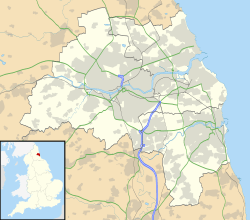Condercum facts for kids
Quick facts for kids Condercum |
|
|---|---|

The Vallum crossing at Condercum
|
|
| Founded | 122 - 124 AD |
| Abandoned | c. 5th century AD |
| Place in the Roman world | |
| Province | Britannia |
| Structure | |
| — Stone structure — | |
| Size and area | 170 m × 120 m (2 ha) |
| Stationed military units | |
| — Legions — | |
|
|
| — Cohorts — | |
| I Vangionum | |
| — Alae — | |
| Hispanorum Asturum | |
| Location | |
| Coordinates | 54°58′34″N 1°39′47″W / 54.976°N 1.663°W |
| Town | Newcastle upon Tyne |
| County | Tyne and Wear |
| Country | England |
| Reference | |
| UK-OSNG reference | NZ216646 |
Condercum was a Roman fort on the site of the modern-day Condercum Estate in Benwell, a suburb of Newcastle upon Tyne, England. It was the third fort on Hadrian's Wall, after Segedunum (Wallsend) and Pons Aelius (Newcastle), and was situated on a hilltop 2 miles (3 km) to the west of the city. Today, nothing can be seen of the fort or its adjoining wall, as the site is covered by a modern reservoir and housing estate, bisected by the A186 Newcastle to Carlisle road, which follows the line of Hadrian's Wall. The remains of a small temple dedicated to Antenociticus, a local deity, can be seen nearby, and the original causeway over the vallum, or rear ditch, can also be seen. A modern-day Condercum Road marks the site.
Description
The remains of the fort lie on Hadrian's Wall to the west of Newcastle. The fort measured 570 feet (170 m) from north to south by 400 feet (120 m) east to west and the defences enclosed an area of just over 5 acres (2.0 ha). It was a cavalry fort, and had three gates leading to the north of the wall. There were two side gates, facing east and west, through which the Roman military road, running along the south side of the wall, entered and exited. There was also a south-facing gate that led to a causeway that crossed the vallum. The causeway had a gateway, halfway across which was closed by doors. The fort contained a commandant's house, headquarters, two granaries, workshops, barracks, stables and a hospital.
Excavation
The fort was excavated in the 1920s to 1930s where a dedication table was found that suggested the origin date of 122 AD. Also, pottery was found that dated to the 2nd century indicating the time of the rebuild. Other finds from the site include altars dedicated to the gods, square-head and cruciform brooches, a strong room or treasure vault, and a silver spoon.
Construction and garrison
It is known from several building inscriptions that the defences of the fort at Benwell were built by soldiers from the Second Augustan Legion (Legio II Augusta). It is believed that it was built between 122 AD and 124 AD. Soldiers from the Twentieth Legion (Legio XX Valeria Victrix) were apparently responsible for some additional building or repair work at Benwell in the late-2nd century.
The fort contained two granaries, and it is known that these were built by a detachment from the British Fleet, probably because the legionaries responsible for construction of the fort had been called away. It is likely that the detachment was sent from nearby Arbeia, in modern-day South Shields.
In the 2nd century Condercum was garrisoned by the Cohors I Vangionum Milliaria Equitata, which was a part-mounted unit from Upper Germany. This had a nominal strength of one thousand men, but it is likely that only half of this number occupied the fort. It is thought that from AD 205 to AD 367, a five-hundred-strong auxiliary cavalry unit (Ala I Hispanorum Asturum), from the Astures tribe in northern Spain, was stationed at the fort.
Other buildings
There is evidence that a village, or vicus, grew up around the fort, lying to the north and south of the vallum. The remains of three notable buildings were found near the fort.
A number of altar-stones have been found at the site, dedicated to various gods. Three of the altars were dedicated to Antenociticus, who is believed to be a Celtic deity. Another dedication to the "three lamiae" may likewise refer to local Celtic deities.
A hundred yards to the east of the fort, the remains of a temple dedicated to Antenociticus, can still be seen. The building, which was discovered in 1862, measures 15 feet (4.6 m) from east to west and 20 feet (6.1 m) from north to south, with an apse extending a further six feet on the south end. It is believed that the apse contained a life-size statue of the god, as a full size head was found, together with the fragments of an arm and a leg. The head was adorned with a Celtic neck torc. The temple also contained three altars to Antenociticus.
Three hundred yards to the southwest of the fort, a bathhouse was discovered in 1751. The building had several rooms, which were probably the hot and cold rooms and dressing rooms normally found in such bathhouses.
Just south of the vallum causeway, a third building was found. This was a large domestic building, believed to be a mansio, or resthouse for official travellers.
Images for kids






